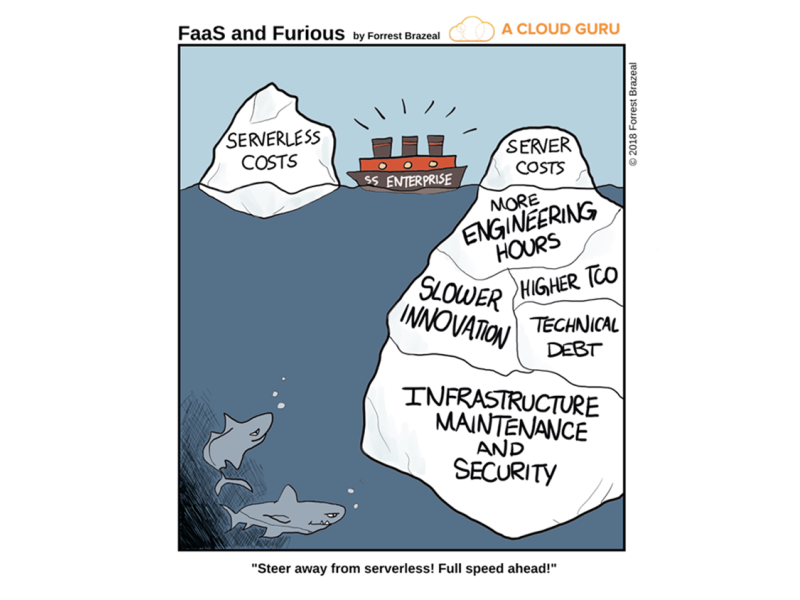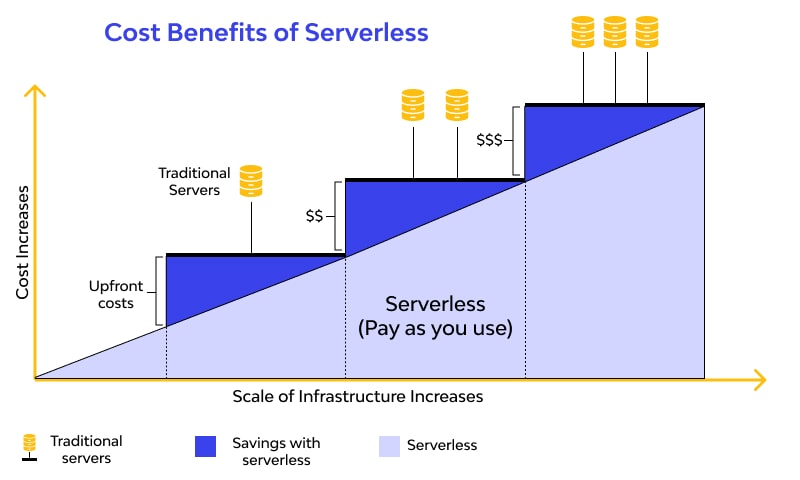Imagine a world where you only pay for the computing resources you actually use, freeing yourself from the burden of maintaining a server around the clock. That’s the promise of serverless architecture.
But before you dive into this exciting new frontier, it’s crucial to understand the costs involved. Whether you’re a tech enthusiast, a business leader, or a developer, understanding serverless architecture cost analysis can empower you to make informed decisions. You might wonder, is serverless truly more cost-effective than traditional server-based models?
We’ll break down the costs, revealing hidden savings and potential pitfalls, so you can optimize your investments and maximize your efficiency. Get ready to uncover the real story behind serverless costs—because your next big tech decision might depend on it!

What Is Serverless Architecture?
Serverless architecture lets developers build applications without managing servers. The cloud provider handles server management. This means scaling, patching, and managing servers is their job. Developers can focus on writing code. No need to worry about server maintenance. This saves a lot of time.
Costs in serverless architecture depend on usage. You only pay for what you use. This is different from traditional servers. There, you pay for the whole server time. Even if it’s not used. This makes serverless more cost-effective for many applications.

Benefits Of Going Serverless
Serverless architecture helps apps grow with ease. It adjusts to more users fast. You do not need extra servers. The system handles changes on its own. This saves time and money. You focus on making your app better. The tech does the scaling work for you.
Serverless means less work for you. No need to worry about servers. You avoid complex setups. The provider manages the hard parts. This reduces stress and errors. Your team can work on other tasks. This frees up time for innovation.
More time for what matters. Serverless allows you to focus on your main goals. Developers write code for key features. No need to manage servers. This boosts efficiency. Your team can deliver new features faster. Customers get better service sooner.
Cost Components In Serverless
Compute costs are based on execution time. Each function run is metered. This means you pay for the time used. Prices vary by provider. AWS Lambda, for example, charges by milliseconds used. These costs can add up quickly. Always monitor usage to control expenses.
Storage costs are for saving data. Serverless services often use cloud storage. Costs depend on the amount stored. Providers like AWS charge for each gigabyte used. Keep an eye on data growth. This helps in managing storage costs efficiently.
Data transfer can be costly. Moving data in and out of the cloud incurs charges. Costs depend on the volume of data. Providers may charge for both inbound and outbound traffic. Reducing data movement can save money. Always plan data transfer needs carefully.
Hidden Savings In Serverless
The pay-per-use modelin serverless architecture is a smart choice. You pay for what you use, no extra costs. This model helps in saving money. No need to spend on unused resources. Costs become predictable and easier to manage.
Over-provisioning is a common issue. Many companies buy more resources than needed. Serverless architecture removes this problem. You only pay for the exact resources used. This helps in cutting down unnecessary expenses.
Maintenance can be expensive. Serverless architecture needs less maintenance. No servers to manage or update. This lowers the cost of operations. It also reduces the need for a big IT team. Businesses can focus on other important tasks.
Comparing Serverless To Traditional Architectures
Serverless architecture often reduces costs by eliminating server management and scaling automatically. Traditional architectures incur higher expenses due to constant server maintenance and unused capacity. Comparing both reveals that serverless can lead to significant savings for businesses with varying workloads.
Upfront Costs Vs. Long-term Savings
Serverless architecture has lower upfront coststhan traditional setups. You pay only for what you use. Traditional systems need servers and hardware. These can be expensive. Over time, serverless can offer long-term savings. Maintenance costs are lower. You don’t manage hardware. This saves money. Less staff needed for upkeep. Serverless scales easily, reducing costs further.
Infrastructure Management Differences
Serverless requires less management. Providers handle the backend. You focus on the code. Traditional systems need more control. You manage everything. This includes servers and networks. It can be complex. Serverless is simpler. You spend more time on development. Less on infrastructure.
Real-world Case Studies
E-commerce businesses save a lot with serverless architecture. No need to manage servers. This reduces costs greatly. Paying only for what they use makes it cheaper. Serverless platforms scale when needed. No extra cost for unused resources. Businesses handle traffic spikes easily. This ensures smooth shopping experiences.
Data processing becomes cheaper with serverless. Companies process data in smaller tasks. This saves money. They pay only for each task. Not for idle time. Tasks run faster and cheaper. Serverless architecture helps handle large data easily. It breaks data into small parts. This saves time and cost.
Challenges In Cost Management
Understanding how much server space you need can be tricky. Usage patterns can change often. This makes planning hard. If usage is low, money is wasted. If usage is high, costs can spike. Being flexible helps, but it’s not always easy. Good tools can help predict these changes.
Third-party services add costs quickly. Many companies use them to save time. But they can be expensive. Each service has its own price. Keeping track of them is a big job. Sometimes, the costs are hidden. It’s important to read all the details. Always check your bills for mistakes. This helps keep costs low.

Best Practices For Cost Optimization
Serverless architecture helps reduce costs by only charging for actual usage. Analyzing usage patterns helps identify wasteful spending. Efficient code execution and optimized resource allocation further cut expenses.
Monitoring And Analyzing Usage
Understanding serverless usage helps save money. Use tools to track usage. Graphs show usage patterns clearly. Alerts notify when usage is high. Reports help find waste. Usage analysis helps plan better. Optimization reduces costs. Monitoring keeps usage under control. Analyzing reveals expensive processes. Efficiency grows with regular checks. Budget planning becomes easier.
Leveraging Reserved And Spot Instances
Reserved instances offer lower rates. Good for predictable workloads. Spot instances save money on less busy times. Flexible tasks benefit from spot pricing. Cost savings grow with strategic planning. Choosing the right instance type is vital. Performance stays high without overspending. Reservation secures a good price. Spot usage helps save on costs. Balance both types for best results. Strategy ensures cost-effective serverless architecture.
Future Trends In Serverless Cost Savings
Cloud technologies are changing fast. Serverless systems help to save money. They offer flexible usage. Pay for what you use. This means cost savings. Many companies adopt this model. It reduces unnecessary expenses. Cloud providers keep improving their services. They add more features. These features help in cost management. New tools come often. They make operations smoother. Innovation in cloud tech is continuous. It supports better decision-making. Companies find easier ways to manage budgets. Efficiency is key in serverless systems. It helps in saving money. Businesses can allocate resources better. Cost efficiency becomes a priority.
AI and machine learning are important in serverless tech. They help in predicting costs. Smart algorithms analyze data. This leads to efficient usage. Businesses benefit from smart insights. AI tools suggest best practices. They enhance cost savings. Machine learning models improve serverless operations. They help in resource allocation. Companies use AI for better budgeting. Predictive analytics aids in cost control. AI tools learn from past data. They suggest ways to save more. Efficient resource usage is the goal. AI helps in achieving it. Businesses gain from automated processes. They lead to significant savings.
Frequently Asked Questions
What Is Serverless Architecture?
Serverless architecture allows developers to build applications without managing servers. It uses cloud services to execute code. This approach reduces operational costs and increases scalability. Developers focus on writing code while the cloud provider handles infrastructure.
How Does Serverless Reduce Costs?
Serverless reduces costs by charging only for actual usage. There are no fixed costs for idle server time. This model is ideal for variable workloads. It eliminates expenses related to server maintenance, reducing operational overhead.
Are Serverless Applications Scalable?
Yes, serverless applications are highly scalable. The architecture automatically adjusts resources based on demand. It handles sudden traffic spikes efficiently. This scalability ensures consistent performance without manual intervention, making it suitable for dynamic applications.
What Are The Hidden Costs Of Serverless?
Hidden costs in serverless include data transfer fees and third-party service charges. Monitoring and debugging can also incur costs. Proper cost analysis is essential to avoid unexpected expenses. Understanding pricing models helps in optimizing serverless architecture costs effectively.
Conclusion
Serverless architecture offers cost efficiency for modern applications. It reduces infrastructure expenses, which benefits businesses of all sizes. Pay-as-you-go pricing ensures you only pay for what you use. This model supports scalability and flexibility. Small startups and large enterprises can both benefit.
With fewer management tasks, teams focus more on innovation. Understanding costs helps optimize budget effectively. Consider serverless for your next project to manage expenses wisely. It’s about smart spending and better resource use. Explore serverless to see if it fits your needs.
Embrace new tech without breaking the bank. Keep evolving with the changing tech landscape.
Read More:
- Network Automation Tools ROI: Boosting Efficiency & Savings
- Noise‑Cancelling Earbuds Battery Life: Maximize Your Usage
- Ci/Cd Pipeline Tools Comparison: Boost Your DevOps Efficiency
- Serverless Vs Containerized Workloads: A Comparative Guide
- Vr Content Creation Tools 2025: Revolutionize Your Creations
- Best Gaming PC Build under $1500: Ultimate Performance
- Best Cross‑Platform Mobile Frameworks 2025: Top Picks
- Javascript Frameworks Benchmark 2025: Speed & Performance

